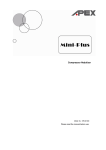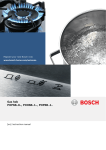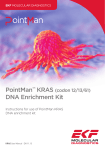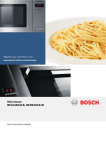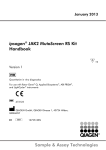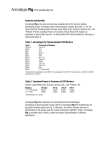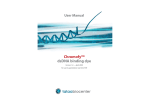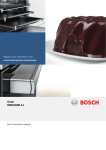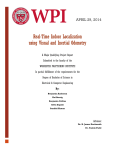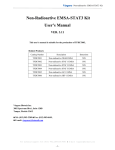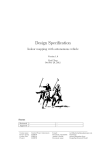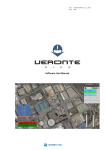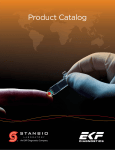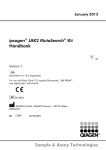Download PointMan™ JAK2 DNA Enrichment Kit
Transcript
EKF MOLECULAR DIAGNOSTICS PointMan™ JAK2 DNA Enrichment Kit Instructions for use of PointMan™ JAK2 DNA enrichment kit JAK2 User Manual EN 11.13 MOLECULAR DIAGNOSTICS Copyright© 2013 EKF Molecular Diagnostics Ltd No part of this publication may be reproduced, transmitted, transcribed, stored in any retrieval system or translated into any human or computer language by any means or in any form, without the prior written permission of EKF Molecular Diagnostics Ltd. Avon House 19 Stanwell Road Cardiff CF64 2EZ United Kingdom Part Number: 7137-9006-0071 T +44 (0)2920 710 570 F +44 (0)2920 710 515 PointMan JAK2 User Manual–EU-EN Date: September 2013 Issue: IFU01 EU-EN-04.13 [email protected] www.ekfmolecular.com Printed in UK Page 2 JAK2 User Manual EN 11.13 Contents Section 1 Kit Contents Section 2 Shipping and Storage Section 3 Product Use Limitations Section 4 Product Warranty and Guarantee Section 5 Quality Control Section 6 Safety Information Section 7 Introduction to PointMan Section 8 Reagents and Equipment to Be Supplied by User Section 9 Sample Material Section 10 Principle of the Test Section 11 Bench-side Protocol Section 12 Amplification Protocol Section 13 Interpretation of Results Section 14 Data Interpretation Section 15 Notices and Disclaimers Section 16 Trademarks JAK2 User Manual EN 11.13 Page 3 Section 1 Kit Contents Kit Contents: PointMan JAK2 Enrichment Kit The PointMan JAK2 kit contains 3 separate primer mixes and control primers. Please read tube contents carefully before preparing individual reactions. • • • • • • • PointMan JAK2 primer mix (24 reactions BLACK) Control primer mix JAK2 (24 reactions WHITE) PointMan JAK2 Mastermix with SYBRgreen (75 reactions GREEN) Sequencing primer forward JAK2 (100 reactions BLUE) Sequencing primer reverse JAK2 (100 reactions BLUE) 1% Positive control JAK2 (20 reactions RED) RNase/DNase free water (WHITE) Section 2 Shipping and Storage The PointMan JAK2 kit is shipped frozen and must still be frozen upon arrival. If the PointMan JAK2 kit is not frozen upon arrival, the outer packing has been opened during transit, the shipment does not contain a packing note, instruction booklet or the reagents please contact the EKF Molecular technical services department ([email protected]). The PointMan JAK2 kit should be stored at -15oC to -25oC and protected from sunlight. When stored under the recommended storage conditions in the original packaging, the PointMan JAK2 kit is stable for 6 months from the date of purchase. Repeated thawing and freezing should be avoided. We recommend a maximum of 7 freeze-thaw cycles. Page 4 JAK2 User Manual EN 11.13 Section 3 Product Use Limitations EKF Molecular Diagnostics sell products solely for use in laboratory research to gain information for use by the purchaser (the “Permitted Use”). By purchasing a PointMan enrichment kit, purchasers undertake that they are purchasing for the Permitted Use only and that purchasers will not use products for any other use, including without limitation: diagnostics for medical purposes or commercial purposes and will not resell any products. Products are covered by patent applications owned by or licenced to EKF Molecular Diagnostics (please see www. ekfmolecular.com). By purchasing any PointMan enrichment kit, purchasers acquire a non-exclusive licence to use the product for the Permitted Use only. EKF Molecular Diagnostics do not warrant that any use of a product will not infringe any patent or any other intellectual property rights whatsoever of any third party. Polymerase Chain Reaction (PCR) is covered by several patents owned by Hoffman-Roche Inc and Hoffman-LaRoche, Ltd. Purchase of EKF Molecular Diagnostics kits does not include or provide any licence with respect to any patents owned by Hoffman-La Roche or others. Section 4 Product Warranty and Guarantee We warrant to you that any product purchased from us will on delivery: conform in all material respects to its specification; be of satisfactory quality (within the meaning of the Sale of Goods Act 1979, as amended) and fit for the purpose held out by us; be free from material defects in design, material and workmanship and; comply with all applicable statutory and regulatory requirements. You may reject any product which does not comply with the above; in the case of a defect that is apparent on normal visual inspection, within five business days of delivery and in the case of a latent defect, within a reasonable time of the latent defect having become apparent. If you reject a product described as above you may either require us to replace the rejected product or require us to repay the price of the rejected goods in full, following return of the goods. Section 5 Quality Control As part of our routine quality assurance program, all EKF Molecular Diagnostics products are manufactured to ISO9001 standards and monitored to ensure the highest levels of performance and reliability. JAK2 User Manual EN 11.13 Page 5 Section 6 Safety Information When working with chemicals, always wear a suitable lab coat, disposable gloves and protective goggles. All chemicals and biological material must be considered as potentially hazardous. Specimens are potentially infectious and must be treated accordingly. Discard sample and assay waste in accordance with your local safety regulations. Section 7 Introduction to PointMan There is an unmet clinical need for the accurate detection and genoptying of rare somatic mutations. The PointMan system is a novel method for selective amplification of genotype specific sequences. Unlike allele specific priming, PointMan does not, in the first instance, achieve results by attempting to selectively prime and amplify mutant sequences. Such methods are ‘leaky’, need extensive optimisation and have limited resolution. By contrast, PointMan uses allele specific primers for priming on the wildtype (WT) sequence and this then drives those WT templates into terminally extended products that are not available for exponential amplification. The variant sequences are uninhibited and therefore free to undergo exponential amplification and enrichment. The system uses 4 primers in total (fig.1). The internal primers confer the selective power of the assay and are called the enriching primers. The external primers are unmodified and are simply used to PCR amplify across the region of interest (amplifying primers). The enriching primers have the 3’ terminal residue situated over the SNP and this residue is homologous with the WT sequence. A second important feature of the enriching primers is that they also contain a PCR blocking residue. Whist this does not prevent binding of the primer and extension on the genomic DNA template, it does prevent the enriching primers from participating in the second and all subsequent rounds of PCR amplification (fig.1). The single stranded template made by the enriching primer on the WT sequences blocks the extension of the full length amplicon from the amplifying primer. In this way, exponential amplification on WT sequences is terminated. Page 6 JAK2 User Manual EN 11.13 Section 7 Introduction to PointMan On variant sequences, the enriching primer does not extend as it is displaced by the enzyme during the extension step. This allows for full exponential amplification across the variant region (fig.1). The PointMan JAK2 kit will exponentially amplify the following sequences if present in the DNA sample. For a full list of the mutations enriched please visit: www.ekfmolecular.com. WT 3’ GGA GTA TGT GTC TGT GGA GAC 5’ V617F 3’ GGA GTA TGC TTC TGT GGA GAC 5’ 1848_1849 TG>CT V617I 3’ GGA GTA TGT ATC TGT GGA GAC 5’ 1849 G>A V617F 3’ GGA GTA TGT TTC TGT GGA GAC 5’ 1849 G>T V617-C618>FR 3’ GGA GTA TGT TTC CGT GGA GAC 5’ 1849_1852 GTCT>TTCC V617-C618>FR 3’ GGA GTA TGT TTT CGT GGA GAC 5’ 1849_1852 GTCT>TTTC V617V 1851 C>T 3’ GGA GTA TGT GTT TGT GGA GAC 5’ JAK2 User Manual EN 11.13 Page 7 11 1 1 WILD TYPE WILD TYPE WILD TYPE VARIANT VARIANT VARIANT WILD TYPE VARIANT WILD TYPE 1 STEP 1 1 VARIANT 22 2 2 STEP 2 2 2 STEP 3 3 STEP 4 4 STEP 5 5 Figure 1: PointMan amplifies the SNP sequence but blocks amplification of the WT sequence Page 8 JAK2 User Manual EN 11.13 Step 1 Enriching primers ((black)) with with blocking blocking moiety moiety ((red ) complementary x) complementary to the to the wildStep 1&2 Wild Type. Enriching ( 3’ to ) the containing blocking moiety ( )(the (the wild-type type sequence sequence and aand mismatch a mismatch atprimers theat3’the end end tovariant the variant (mutant) (mutant) sequence sequence complementary toshown the wild-type sequence with to sample DNA base of interest is as: wild-type – blue ;bind variant oval; variant – high ). Amplifying -avidity red oval). primers Amplifying (orange) primers Step 1 &complementary 2 Wild Enriching primers ( region containing blocking moiety (of) interest and extend. Amplifying primers ( ) prime at) the sites flanking the sequence (orange) complementary toType sequences to sequences flanking the flanking ofregion interest. of interest. complimentary the extension wild type sequence withofhigh avidity to sample DNA but are blockedto from by theanneal highbind avidity the with extended enriching primers Step 2 Wild-Type. Enriching primers to wild-type highsequence avidity due to match and extend. Amplifying primers ( ) prime at sites flanking the (at ).3’ end; extension from enriching primers occurs, further increasing avidity.ofAmplifying interest but are blocked from extension by the high avidity of the extended Variant. anneal Enriching primers do not efficiently and extend due to at the primers and but extension is anneal terminated by presence ofmismatch the extending enriching primers ( extend, ). 3’ end andprimer. stringency of PCR conditions. Amplifying primers therefore extend right enriching Variant. Enriching do not efficiently anneal and extend due to mismatch through the regionprimers of interest, without hindrance. Variant. primers doofnot efficiently anneal and extend duetherefore to mismatch at the at the 3’ Enriching end and stringency PCR conditions. Amplifying primers 3’ end and stringency of PCR conditions. Amplifying primers therefore extend right extend right through the region of interest, without hindrance. Steps 3& Wild-Type. Wild Type. In the subsequent cycle, only products from the through the4 region of interest, without hindrance. enriching primers are available for further replication. replication is terminated Inthe thesubsequent subsequent cycle,only onlyThis the product extension from Steps 3 & 4 Wild-Type. Wild Type In cycle, products fromofthe enriching by the blocking moieties ( ) and the product does not contain any further the enriching primersfor provides sitesThis for further replication however extension is primers are available furtherpriming replication. replication is terminated priming sites. terminated by the blocking and therefore the contain productany does not itself contain by the blocking moieties ( )moieties, and the product does not further Variant. Products amplifying primersreplication are available for priming and extension. any priming sites. of Therefore no further is possible in subsequent cycles, priming sites. and the reaction is driven into linear amplification based only on the original sample Variant. Products of amplifying primers are available for priming and extension. material. Step 5: Wild Type. Lack of priming sites for either set of primers ( ) ensures Variant. In replication subsequent stemming from the set full of replicons by only ofcycles, starting template. Steplinear 5: Wild Type Lack of priming sites for either primersunencumbered ( ) ensures blocking moieties, exponential amplification proceeds in the usual way. only linear replicationamplification of starting template. Variant. Exponential of PCR products is possible. Note thatExponential there is no amplification risk of false positives from mispriming: no extraneous source of the Variant. of PCR products is possible. variant the variant sequence sequence is introduced is introduced in the in the formform of primers of primers (unlike (unlike allele-specific allele-specific PCRPCR andand its variants). its variants). Note that there is no risk of false positives from mispriming: no extraneous source of variant sequence is introduced in the form of primer-dimers (unlike allele specific PCR and its variants) JAK2 User Manual EN 11.13 Page 9 Section 8 Equipment and Reagents to be Supplied by User When working with chemicals, always wear a suitable lab coat, disposable gloves, and protective goggles. For more information, consult the appropriate material safety data sheets (MSDSs), available from the product supplier. • • • • • • • DNA sample (see below) Dedicated pipettes (adjustable) for PCR master mix preparation* Dedicated pipettes (adjustable) for dispensing of DNA* sample Sterile pipette tips with filters Benchtop centrifuge with rotor for 1.5 ml reaction tubes Real-time PCR instrument Sterile microcentrifuge tubes for preparing master mixes Section 9 Suitable Sample Material PointMan will work with any high quality source of extracted human DNA and is therefore compatible with a wide range of extraction protocols. DNA samples should be quality checked and quantified using a UV spectrophotometer or similar approach. Page 10 JAK2 User Manual EN 11.13 General precautions The user should always pay attention to the following: Use sterile pipette tips with filters and make sure that pipettes have been calibrated according to the manufacturer’s instructions. Store and extract positive materials (samples and positive controls) separately from all other reagents and add them to the reaction mix in a spatially separated facility or within a laminar flow cabinet. Thaw all components thoroughly on ice before starting an assay. When thawed, mix the components by inverting each tube 10 times and centrifuge briefly. Do not vortex the mastermix as this may inactivate the Taq DNA polymerase. Use extreme caution to prevent contamination of PCRs with synthetic control material. We recommend using separate, dedicated pipettes for setting up reaction mixes and adding DNA template. Preparation and dispensing of reaction mixes must be carried out in a separate area to the addition of sample. Reagents for the PointMan JAK2 kit have been optimally diluted. EKF Molecular Diagnostics do not recommend further dilution of reagents as this may result in a loss of performance. We do not recommend using reaction volumes of less than 15 μl as this may increase the risk of false negatives. All reagents in the PointMan JAK2 Kit are formulated specifically for use with the stated tests. All reagents supplied in the PointMan JAK2 Kit are intended to be used solely with the other reagents in the same Kit. Substitutions to the reagents in the kit must not be made if optimal performance is to be maintained. Only use the Taq DNA polymerase that is provided in the kit. Do not substitute with Taq DNA polymerase from other kits of the same or any other type, or with Taq DNA polymerase from another supplier. * Ensure that all instruments have been checked and calibrated according to the manufacturer’s recommendations. JAK2 User Manual EN 11.13 Page 11 Section 10 Principles of the Test PointMan Primer Mix (Black) This primer mix contains the 4 primers required for a PointMan reaction. When used in conjunction with the PointManTM Mastermix and user supplied DNA sample, this reaction will selectively enrich the PCR reaction for variant sequences, if present. Following PointMan reaction completion, the enriched product can be sequenced to confirm if the variant sequence is present in the tissue sample. Control Primer Mix (White) TThe PointMan reaction blocks amplification of the wide type (WT) sequence, thus it follows that clinical samples which contain only the WT sequence may not produce any amplification product. Experimentally, it has been demonstrated that if the sample contains less than 1000 copies of WT sequence, no PCR product will accumulate. For this reason it is essential to confirm that the sample has been extracted correctly and is competent to support PointMan PCR amplification. The control primer mix contains only the amplifying primers without the enriching primers. This mix will therefore produce a post reaction product on both WT and variant sequences. The control primer mix is used to confirm that a biological sample is competent for PCR and therefore valid for PointMan analysis. A positive signal from the control assay primers is essential to enable validation of negative results. PointMan Mastermix with SYBRgreen (Green) The PointMan Mastermix is specifically formulated to provide optimal blocking of amplification on WT sequences whist allowing efficient amplification of variant sequences. Consistent with the PointMan process outlined above, the enzyme is exonuclease deficient. The mastermix also contains SYBRgreen. This allows the monitoring of product accumulation in real time and also permits melting curve analysis to ensure that a single amplicon, corresponding to JAK2, has been amplified. Analysis of the SYBRgreen data following PointMan enrichment enables the user to validate that PointManTM has produced a PCR product prior to sample sequencing. The PointMan Mastermix cannot be substituted for another enzyme and buffer system as this will greatly affect the sensitivity of the enrichment. Page 12 JAK2 User Manual EN 11.13 PointMan Sequencing Primers (Yellow) To confirm the presence of variant sequences following PointManTM enrichment, samples can be sequenced using the sequence primers provided to prime the reaction. The sequencing primer is unlabelled and is supplied lyophilized. Section 11 Bench-side Protocol To minimise the risk of contamination with foreign DNA, EKF Molecular Diagnostics recommend that all pipetting be performed in a PCR clean environment. Ideally this would be a designated PCR cabinet. Filter tips are recommended for all pipetting steps. 1.Pulse-spin each tube in a centrifuge before opening. This ensures all products are situated in the base of the tube and prevents reagent loss upon opening the tube. 2.Resuspend all components according to the table below using RNase/DNase free water supplied. COMPONENT VOLUME PointMan primer mix 72 µl Control primer mix 72 µl Forward sequencing primer* 110 µl Reverse sequencing primer* 110 µl 1% positive control ** 100 µl * 3.2 pmol per µl when resuspended ** Contamination risk - contains high copy number of positive control template JAK2 User Manual EN 11.13 Page 13 Preparation of a PointMan reaction Please note that the PointMan JAK2 enrichment kit contains 3 separate primer mixes and control primers. Please read tube contents carefully before preparing individual reactions. 1.Make up reaction mixes For each sample make up a reaction mix for both the PointMan test and the control well. Remember to include additional reactions for the positive and negative controls. COMPONENT 1 REACTION PointMan primer mix (BLACK) 2 µl PointMan Mastermix with SYBRgreen (GREEN) 10 µl RNAse/DNAse free water (CLEAR) 3 µl Final volume 15 µl Control primer mix (WHITE) 2 µl PointMan Mastermix with SYBRgreen (GREEN) 10 µl RNAse/DNAse free water (WHITE) 3 µl Final volume 15 µl 2.Pipette 15 μl of relevant reaction mix into each well according to your PointMan experimental plate set up. e.g. SAMPLE SAMPLE SAMPLE SAMPLE SAMPLE POSITIVE 1 2 3 4 5 CTRL NTC PointMan Control primer 3.Add 5 μl of DNA sample to each reaction Ideally 1-10 ng of high quality DNA should be used. For no template controls (NTC)/ negative control wells replace sample with RNAse/DNAse free water. For the 1% positive control well, use 5 µl of control template (Red). Page 14 JAK2 User Manual EN 11.13 Section 12 Amplification Protocol PointMan uses a carefully optimised 4 step cycling parameter. Please follow this protocol exactly using a block based real time PCR machine. COMPONENT STEP TIME TEMP Enzyme Activation (if required) 2 mins 95 °C Denaturation 10 s 95 °C Primer Annealing 20 s 50 °C Enriching Primer Displacement 1s 70 °C Extension* 30 s 60 °C 50 CYCLES MELT CURVE 60-90 °C in 1 °C intervals * * Flourogenic data should be collected during these steps through the SYBRgreen/FAM channel JAK2 User Manual EN 11.13 Page 15 Section 13 Interpretation of Results Real time PCR traces Analysis of the real time PCR data should give amplification plots with CT values of between 25 and 40. Please note that variant traces will appear before the WT traces due to exponential amplification of the variant sequence. VARIANT WT Melting curve analysis Melting temperatures for PCR products for JAK2 are shown below. The melting curve should give a single peak with a melting temperature of 78°C as shown above. Page 16 JAK2 User Manual EN 11.13 Section 14 Table 1: Data Interpretation CONTROL PRIMERS POINTMAN PRIMER MIX INTERPRETATION Amplicon produced Amplicon produced with melting Tm 78oC Positive for a variant sequence. Confirm by sequence analysis Amplicon produced NO Amplicon produced Reaction successful but no variant sequences amplified. The sample is WT NO Amplicon produced NO Amplicon produced The sample has failed. Either there was insufficient amplifiable or PCR inhibitors have prevented a successful test Mutation Details Cosmic IDs are taken from the Catalogue of Somatic Mutations in Cancer (www.sanger.ac.uk/genetics/CGP/cosmic). Table 2: List of JAK2 mutations and COSMIC IDs. Amino Acid Sequence Change Base Change Cosmic ID WT 3’ GGA GTA TGT GTC TGT GGA GAC 5’ V617F 3’ GGA GTA TGC TTC TGT GGA GAC 5’ 1848_1849 TG>CT 25834 V617I 3’ GGA GTA TGT ATC TGT GGA GAC 5’ 1849 G>A 29117 V617F 3’ GGA GTA TGT TTC TGT GGA GAC 5’ 1849 G>T 12600 V617-C618>FR 3’ GGA GTA TGT TTC CGT GGA GAC 5’ 1849_1852 GTCT>TTCC 29281 V617-C618>FR 3’ GGA GTA TGT TTT CGT GGA GAC 5’ 1849_1852 GTCT>TTTC 27624 V617V 1851 C>T 3’ GGA GTA TGT GTT TGT GGA GAC 5’ 51409 Numerous mutations and deletions in JAK2 codons 617 AND 618 are reported. For a full list of the possible mutations enriched by this component of the kit, please visit www.ekfmolecular.com. JAK2 User Manual EN 11.13 Page 17 Section 15 Notices and Disclaimers These products are sold exclusively for research and development (R&D) use by the purchaser. PointMan enrichment kits may not be used for human or veterinary in vitro diagnostic (IVD) applications and they may not be re-sold, distributed or re-packaged without express written authorisation from EKF Molecular Diagnostics. License statement: Enzymes designed and sold for use in Amplification Patent Rights and/or Sequencing Patent Rights. A license under US Patents 4,683,202, 4,683,195, 4,965,188, and 5,075,216 or their foreign counterparts, owned by Hoffmann-La Roche Inc. and F. Hoffmann-La Roche Ltd. (“Roche”), has an up-front fee component and a running-royalty component. The purchase price of this product includes limited, nontransferable rights under the running-royalty component to use only this amount of the product to practice the Polymerase Chain Reaction (“PCR”) and related processes described in said patents solely for the research and development activities of the purchaser when this product is used in conjunction with a thermal cycler whose use is covered by the up-front fee component. Rights to the up-front fee component must be obtained by the end user in order to have a complete license to use this product in the PCR process. These rights under the up-front fee component may be purchased from Perkin-Elmer or obtained by purchasing an authorized Thermal Cycler. No right to perform or offer commercial services of any kind using PCR, including without limitation reporting the results of purchaser’s activities for a fee or other commercial consideration, is hereby granted by implication or estoppel. Further information on purchasing licenses to practice the PCR process may be obtained by contacting the Director of Licensing at The Perkin-Elmer Corporation, 850 Lincoln Center Drive, Foster City, California 94404 or at Roche Molecular Systems, Inc., 1145 Atlantic Avenue, Alameda, California 94501. The purchase of EKF Molecular Diagnostics reagents cannot be construed as an authorization or implicit license to practice PCR under any patents held by Hoffmann-LaRoche Inc or others. PointMan Mastermix containing GoTaq® Hot Start Polymerase manufactured by Promega Corporation for distribution by EKF Molecular Diagnostics. Licensed to Promega under U.S. Patent Nos. 5,338,671 and 5,587,287 and their corresponding foreign patents. Page 18 JAK2 User Manual EN 11.13 NOTES Notes JAK2 User Manual EN 11.13 Page 19 Page 20 JAK2 User Manual EN 11.13




















